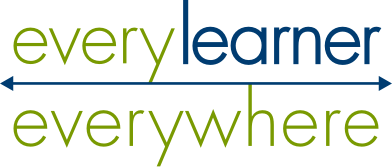Higher education is on the verge of a “paradigm shift,” as a recent webinar hosted by Achieving the Dream with support from Every Learner Everywhere put it, to center equity and anti-racism, and that is trickling down to and filtering up from day-to-day equity-minded teaching practices.
The Paradigm Shift: What Happens When Taking an Equity-Minded Approach to Teaching and Learning featured three faculty describing in detail changes in the teaching practice they’ve implemented to realize the potential of inclusive, culturally responsive, and anti-racist practices that address equity gaps. It was one of a series of webinars in the three-day Achieving the Dream Teaching and Learning Institute: Being an Equity-Minded Educator in April 2022.
“The task,” said Ayse Durmus, an English instructor at the University of Colorado, is to design “affirming and sustaining places and spaces where students bring their authentic selves and their knowledge and expertise to contribute to the community of learners we co-create with them.”
In other words, she said, paraphrasing New York University professor David Kirkland, the paradigm shift needed is from “creating schools that our students deserve” to “creating schools that deserve our students.”
Durmus cited the need to reimagine the student-teacher dynamic as a partnership, in which students co-design the curriculum and “have active ownership of their learning through project-based teaching, problem-solving tasks, and storytelling and their cultural perspective.” A student-centered approach turns their lived experiences, interests, and strengths into opportunities for academic success so practitioners understand what their students’ dreams are and what they’re striving to be.”
Tear down that wall: creating a student-teacher community
The first step toward establishing a partnership with students is to break down the natural barriers that separate them from teachers, said Shirley Burnett, interim department chair and instructor in mathematics at University College, Jackson State University.
“I give students an opportunity to really introduce themselves to me,” Burnett explained. “I’ll let them use videos. If they have a picture of themselves, I let them talk about the picture — why it was so important to them — and what that did was break down that barrier.”
At the same time, Burnett also allows students to get to know her. “I give them just a little bit of me — show and share with them videos or pictures of me doing things outside of the educational arena.”
Once introductions are out of the way, Burnett nurtures the sense of partnership by inviting students to help set the tone of the course. “I ask them what they hate for a math teacher to do,” she said. “How do they prefer to learn math? So that allows them to open up, to let them know that whatever instructional preference that’s important to you, I’m going to try to embrace. I always try to make sure that I help them to see how the math they’re learning applies to them every day — to make it relevant and applicable in their world.”
Related reading: How Faculty Are Using Reflection Activities To Improve Student Engagement in Intro Courses
Bridging the cultural gap
Vincent Cheng, professor and chairman of the department of Speech, Communication and Theatre Arts at Borough of Manhattan Community College, zeroed in on one of his most widely taken courses, Fundamentals of Public Speaking. “Unfortunately, this is also one of the most failed courses at BMCC,” Cheng said.
Cheng resolved to address the achievement gap, “in a holistic way,” especially among the large Black, Latino, and Asian-American student population.
“We actually developed our own OER textbook,” he said. “We wanted to make it somehow more reflective of not just the discipline from the Western, Eurocentric perspective.” Cheng and his colleagues also sought “to infuse culturally responsive pedagogies, trauma-informed pedagogies, and anti-racist pedagogy into our newly designed Speech 100 class.”
Related reading: How Borough of Manhattan Community College Adjunct Faculty are Equitizing the Syllabus in a Gateway Course
Like Burnett, Cheng makes sure students know who he is and where he’s coming from. “I introduce myself with student-centered language in such a way to make them feel welcome and say ‘I am in this with you, I’m gonna learn with you . . . . I can’t wait to embark on this journey with you.’ I firmly believe that with the right conditions and environment, everyone can learn anything, even something as seemingly daunting as public speaking,”
Cheng’s introductory assignment to students is to discuss “their names, their identities, values, and goals. We’ve talked about stereotypes that have caused certain conflicts in their lives, and how they negotiate that, which creates very rich discussions within my classrooms . . . . I ask them to transform this assignment into some type of digital storytelling video introduction.”
Building community
In her math courses, Burnett creates a sense of community by breaking the class up into four groups, and switching up the members throughout the semester. “The classroom is just vibrant because everybody’s getting to know each other,” she said.
The interplay allows for classmates to learn about their different lifestyles, households and cultures, which helps create a supportive atmosphere. “It’s just a breath of fresh air. At the same time, the students are actually learning the content and seeing how it relates to them, and everyday life.”
Durmus added that it’s important that students see themselves as “not only as members of a social community, but also an intellectual community through affirming conversations about their skill sets, expertise, and socio-cultural conversations about their developing and learning processes and group work. They also have to be able to say, ‘This work has value for me.’”
Recruiting a faculty committed to the paradigm shift
At diverse institutions like BMCC, equity-minded teaching should be part of the faculty DNA. And that’s a challenge for department chair Cheng.
“We share best practices, doing departmental meetings every chance we can, and to really embed equity into everything we do, and every decision we make, and every course we offer within the department,” he said.
“When it comes to hiring practice, now we include culturally responsive pedagogy and anti-racist pedagogy as a requirement. We actually spell those things out in our job search. We’ve made it very clear that we will expect faculty members, as a standard of practice, to have these pedagogy tools and skills.”
Subscribe to our mailing list to be alerted to future teaching and learning webinars


